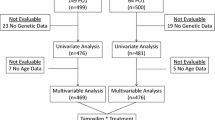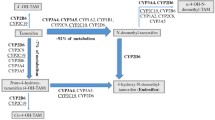Abstract
The clinical importance of CYP2D6 genotype as predictor of tamoxifen efficacy is still unclear. Recent genotyping studies on CYP2D6 using DNA derived from tumor blocks have been criticized because loss of heterozygosity (LOH) in tumors may lead to false genotype assignment. Postmenopausal early breast cancer patients who were randomized to receive tamoxifen, followed by exemestane in a large randomized controlled trial were genotyped for five CYP2D6 alleles. CYP2D6 genotypes and phenotypes were related to disease-free survival during tamoxifen use (DFS-t) in 731 patients. By analyzing microsatellites flanking the CYP2D6 gene, patients whose genotyping results were potentially affected by LOH were excluded. In addition, exploratory analyses on 24 genetic variants of other metabolic enzymes and the estrogen receptor were performed. For the CYP2D6 analysis, only 2.3 % of the samples were excluded, because influence of LOH could not be ruled out. No association was found between the CYP2D6 genotype or predicted phenotype and DFS-t (poor vs. extensive metabolizers: unadjusted hazard ratio 1.33, 95 % CI 0.52–3.43; P = 0.55). DFS-t was associated with UGT2B15*2 (Vt/Vt + Wt/Vt vs. Wt/Wt: adjusted hazard ratio 0.47, 95 % CI 0.25–0.89; P = 0.019) and the estrogen receptor-1 polymorphism ESR1 PvuII (gene–dose effect: adjusted hazard ratio 1.63, 95 % CI 1.04–2.54; P = 0.033). In postmenopausal early breast cancer patients treated with adjuvant tamoxifen followed by exemestane neither CYP2D6 genotype nor phenotype did affect DFS-t. This is in accordance with two recent studies in the BIG1-98 and ATAC trials. Our study is the first CYP2D6 association study using DNA from paraffin-embedded tumor tissue in which potentially false interpretation of genotyping results because of LOH was excluded. Polymorphisms in the estrogen receptor-1 and UGT2B15 may be associated with tamoxifen efficacy, but these findings need replication.



Similar content being viewed by others
References
Desta Z, Ward BA, Soukhova NV, Flockhart DA (2004) Comprehensive evaluation of tamoxifen sequential biotransformation by the human cytochrome P450 system in vitro: prominent roles for CYP3A and CYP2D6. J Pharmacol Exp Ther 310:1062–1075
Stearns V, Johnson MD, Rae JM, Morocho A, Novielli A, Bhargava P et al (2003) Active tamoxifen metabolite plasma concentrations after coadministration of tamoxifen and the selective serotonin reuptake inhibitor paroxetine. J Natl Cancer Inst 95:1758–1764
Jin Y, Desta Z, Stearns V, Ward B, Ho H, Lee KH et al (2005) CYP2D6 genotype, antidepressant use, and tamoxifen metabolism during adjuvant breast cancer treatment. J Natl Cancer Inst 97:30–39
Lim YC, Desta Z, Flockhart DA, Skaar TC (2005) Endoxifen (4-hydroxy-N-desmethyl-tamoxifen) has anti-estrogenic effects in breast cancer cells with potency similar to 4-hydroxy-tamoxifen. Cancer Chemother Pharmacol 55:471–478
Lim YC, Li L, Desta Z, Zhao Q, Rae JM, Flockhart DA et al (2006) Endoxifen, a secondary metabolite of tamoxifen, and 4-OH-tamoxifen induce similar changes in global gene expression patterns in MCF-7 breast cancer cells. J Pharmacol Exp Ther 318:503–512
Wu X, Hawse JR, Subramaniam M, Goetz MP, Ingle JN, Spelsberg TC (2009) The tamoxifen metabolite, endoxifen, is a potent antiestrogen that targets estrogen receptor alpha for degradation in breast cancer cells. Cancer Res 69:1722–1727
Murdter TE, Schroth W, Bacchus-Gerybadze L, Winter S, Heinkele G, Simon W et al (2011) Activity levels of tamoxifen metabolites at the estrogen receptor and the impact of genetic polymorphisms of phase I and II enzymes on their concentration levels in plasma. Clin Pharmacol Ther 89:708–717. doi:10.1038/clpt.2011.27
Goetz MP, Rae JM, Suman VJ, Safgren SL, Ames MM, Visscher DW et al (2005) Pharmacogenetics of tamoxifen biotransformation is associated with clinical outcomes of efficacy and hot flashes. J Clin Oncol 23:9312–9318
Schroth W, Goetz MP, Hamann U, Fasching PA, Schmidt M, Winter S et al (2009) Association between CYP2D6 polymorphisms and outcomes among women with early stage breast cancer treated with tamoxifen. JAMA 302:1429–1436
Dezentje VO, Guchelaar HJ, Nortier JW, van de Velde CJ, Gelderblom H (2009) Clinical implications of CYP2D6 genotyping in tamoxifen treatment for breast cancer. Clin Cancer Res 15:15–21
Lash TL, Lien EA, Sorensen HT, Hamilton-Dutoit S (2009) Genotype-guided tamoxifen therapy: time to pause for reflection? Lancet Oncol 10:825–833
Dezentje VO, van Blijderveen NJ, Gelderblom H, Putter H, van Herk-Sukel MP, Casparie MK et al (2010) Effect of concomitant CYP2D6 inhibitor use and tamoxifen adherence on breast cancer recurrence in early-stage breast cancer. J Clin Oncol 28:2423–2429
Kelly CM, Juurlink DN, Gomes T, Duong-Hua M, Pritchard KI, Austin PC et al (2010) Selective serotonin reuptake inhibitors and breast cancer mortality in women receiving tamoxifen: a population based cohort study. BMJ 340:c693
Abraham JE, Maranian MJ, Driver KE, Platte R, Kalmyrzaev B, Baynes C et al (2010) CYP2D6 gene variants: association with breast cancer specific survival in a cohort of breast cancer patients from the United Kingdom treated with adjuvant tamoxifen. Breast Cancer Res 12:R64
Goetz M, Berry D, Klein T, International Tamoxifen Pharmacogenomics Consortium (2009) Adjuvant tamoxifen treatment outcome according to cytochrome P450 2D6 (CYP2D6) phenotype in early stage breast cancer: findings from the International Tamoxifen Pharmacogenomics Consortium. Cancer Res 69:33
Regan MM, Leyland-Jones B, Bouzyk M, Pagani O, Tang W, Kammler R et al (2012) CYP2D6 genotype and tamoxifen response in postmenopausal women with endocrine-responsive breast cancer: the breast international group 1–98 trial. J Natl Cancer Inst 104:441–451. doi:10.1093/jnci/djs125
Rae JM, Drury S, Hayes DF, Stearns V, Thibert JN, Haynes BP et al (2012) CYP2D6 and UGT2B7 genotype and risk of recurrence in tamoxifen-treated breast cancer patients. J Natl Cancer Inst 104:452–460. doi:10.1093/jnci/djs126
Madlensky L, Natarajan L, Tchu S, Pu M, Mortimer J, Flatt SW et al (2011) Tamoxifen metabolite concentrations, CYP2D6 genotype, and breast cancer outcomes. Clin Pharmacol Ther 89:718–725. doi:10.1038/clpt.2011.32
Gjerde J, Hauglid M, Breilid H, Lundgren S, Varhaug JE, Kisanga ER et al (2008) Effects of CYP2D6 and SULT1A1 genotypes including SULT1A1 gene copy number on tamoxifen metabolism. Ann Oncol 19:56–61. doi:10.1093/annonc/mdm434
Nishiyama T, Ogura K, Nakano H, Ohnuma T, Kaku T, Hiratsuka A et al (2002) Reverse geometrical selectivity in glucuronidation and sulfation of cis- and trans-4-hydroxytamoxifens by human liver UDP-glucuronosyltransferases and sulfotransferases. Biochem Pharmacol 63:1817–1830
Sun D, Sharma AK, Dellinger RW, Blevins-Primeau AS, Balliet R, Chen G et al (2007) Glucuronidation of active tamoxifen metabolites by the human UDP-glucuronosyltransferases (UGTs). Drug Metab Dispos 35:2006–2014
Nakamura Y, Ratain MJ, Cox NJ, McLeod HL, Kroetz DL, Flockhart DA (2012) Re: CYP2D6 genotype and tamoxifen response in postmenopausal women with endocrine-responsive breast cancer: the Breast International Group 1–98 trial. J Natl Cancer Inst 104:1264–1268. doi:10.1093/jnci/djs304
Pharoah PD, Abraham J, Caldas C (2012) Re: CYP2D6 genotype and tamoxifen response in postmenopausal women with endocrine-responsive breast cancer: the Breast International Group 1–98 trial and Re: CYP2D6 and UGT2B7 genotype and risk of recurrence in tamoxifen-treated breast cancer patients. J Natl Cancer Inst 104:1263–1264. doi:10.1093/jnci/djs312
Stanton V Jr (2012) Re: CYP2D6 genotype and tamoxifen response in postmenopausal women with endocrine-responsive breast cancer: the Breast International Group 1–98 trial. J Natl Cancer Inst 104:1265–1266. doi:10.1093/jnci/djs305
Wheeler HE, Maitland ML, Dolan ME, Cox NJ, Ratain MJ (2012) Cancer pharmacogenomics: strategies and challenges. Nat Rev Genet 14:23–34. doi:10.1038/nrg3352
Castells A, Gusella JF, Ramesh V, Rustgi AK (2000) A region of deletion on chromosome 22q13 is common to human breast and colorectal cancers. Cancer Res 60:2836–2839
van de Velde CJ, Rea D, Seynaeve C, Putter H, Hasenburg A, Vannetzel JM et al (2011) Adjuvant tamoxifen and exemestane in early breast cancer (TEAM): a randomised phase 3 trial. Lancet 377:321–331
Baak-Pablo R, Dezentje V, Guchelaar HJ, van der Straaten T (2010) Genotyping of DNA samples isolated from formalin-fixed paraffin-embedded tissues using preamplification. J Mol Diagn 12:746–749
Ahern TP, Christensen M, Cronin-Fenton DP, Lunetta KL, Rosenberg CL, Sorensen HT et al (2010) Concordance of metabolic enzyme genotypes assayed from paraffin-embedded, formalin-fixed breast tumors and normal lymphatic tissue. Clin Epidemiol 2:241–246. doi:10.2147/CLEP.S13811
Rae JM, Sikora MJ, Henry NL, Li L, Kim S, Oesterreich S et al (2009) Cytochrome P450 2D6 activity predicts discontinuation of tamoxifen therapy in breast cancer patients. Pharmacogenomics J 9:258–264
Thompson AM, Johnson A, Quinlan P, Hillman G, Fontecha M, Bray SE et al (2010) Comprehensive CYP2D6 genotype and adherence affect outcome in breast cancer patients treated with tamoxifen monotherapy. Breast Cancer Res Treat 125:279–287
Kiyotani K, Mushiroda T, Hosono N, Tsunoda T, Kubo M, Aki F et al (2010) Lessons for pharmacogenomics studies: association study between CYP2D6 genotype and tamoxifen response. Pharmacogenet Genomics 20:565–568
Court MH, Hao Q, Krishnaswamy S, Bekaii-Saab T, Al-Rohaimi A, von Moltke LL et al (2004) UDP-glucuronosyltransferase (UGT) 2B15 pharmacogenetics: UGT2B15 D85Y genotype and gender are major determinants of oxazepam glucuronidation by human liver. J Pharmacol Exp Ther 310:656–665
Ahern TP, Christensen M, Cronin-Fenton DP, Lunetta KL, Soiland H, Gjerde J et al (2011) Functional polymorphisms in UDP-glucuronosyl transferases and recurrence in tamoxifen-treated breast cancer survivors. Cancer Epidemiol Biomarkers Prev 20:1937–1943
Jin Y, Hayes DF, Li L, Robarge JD, Skaar TC, Philips S et al (2008) Estrogen receptor genotypes influence hot flash prevalence and composite score before and after tamoxifen therapy. J Clin Oncol 26:5849–5854
Onitilo AA, McCarty CA, Wilke RA, Glurich I, Engel JM, Flockhart DA et al (2009) Estrogen receptor genotype is associated with risk of venous thromboembolism during tamoxifen therapy. Breast Cancer Res Treat 115:643–650
Hayes DF, Skaar TC, Rae JM, Henry NL, Nguyen AT, Stearns V et al (2010) Estrogen receptor genotypes, menopausal status, and the effects of tamoxifen on lipid levels: revised and updated results. Clin Pharmacol Ther 88:626–629. doi:10.1038/clpt.2010.143
van Duijnhoven FJ, Peeters PH, Warren RM, Bingham SA, Uitterlinden AG, van Noord PA et al (2006) Influence of estrogen receptor alpha and progesterone receptor polymorphisms on the effects of hormone therapy on mammographic density. Cancer Epidemiol Biomarkers Prev 15:462–467
Cuzick J, Warwick J, Pinney E, Warren RM, Duffy SW (2004) Tamoxifen and breast density in women at increased risk of breast cancer. J Natl Cancer Inst 96:621–628
Grabinski JL, Chisholm G, Smith LS, Drengler RL, Kalter S, Rodriguez G et al. (2008) ER alpha genotypes and breast cancer recurrence. J Clin Oncol 26(15S):501
Acknowledgments
We would like to thank the women participating in the TEAM trial and Tom van Wezel for his intellectual contribution and assistance in the microsatellite analysis. The core TEAM trial was supported by an unrestricted research grant from Pfizer Inc. The current separate pharmacogenetic study was not financially supported. Pfizer had no role in writing of this manuscript or decision to submit.
Disclosure
The authors have declared no conflicts of interest.
Author information
Authors and Affiliations
Corresponding author
Electronic supplementary material
Below is the link to the electronic supplementary material.
Rights and permissions
About this article
Cite this article
Dezentjé, V.O., van Schaik, R.H.N., Vletter-Bogaartz, J.M. et al. CYP2D6 genotype in relation to tamoxifen efficacy in a Dutch cohort of the tamoxifen exemestane adjuvant multinational (TEAM) trial. Breast Cancer Res Treat 140, 363–373 (2013). https://doi.org/10.1007/s10549-013-2619-6
Received:
Accepted:
Published:
Issue Date:
DOI: https://doi.org/10.1007/s10549-013-2619-6




